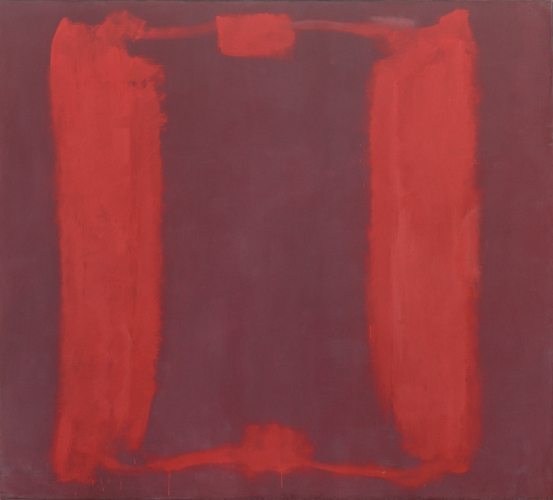If you could only hear—but not see—the goings-on in the Harvard Art Museums’ Special Exhibitions Gallery, your imagination would probably run wild each day around 4pm. One afternoon you might notice spontaneous applause, leading you to assume that a rousing lecture or theatrical production had just concluded. On another, gasps and lofty praise (“Amazing!” “Incredible!”) could spill out of the room, convincing you that a death-defying magic trick had been successfully pulled off. And on still another day, wistful “awww”s might make you think something disappointing had occurred—a live feed of a frolicking baby panda or puppies suddenly went black, maybe.
But all these auditory dramatics have actually been elicited by the same daily event: the switching off of digital projectors trained on Mark Rothko’s Harvard Murals. These projectors, the result of years of research, analysis, and painstaking conservation work by art historians, conservators, and curators, cast non-invasive light to replicate and match the original hues in Rothko’s five panels from 1962, virtually reversing decades of discoloration caused by sun damage and other factors.
From 10am until 4pm daily, the projectors remain on. But at 4pm, a museum attendant or other staff member switches them off, one by one, so that visitors can see the murals in their uncorrected state.
The occurrence (which lasts only about a minute in total) has become something of a minor attraction, with usually at least a dozen visitors, and sometimes up to about 50 individuals, crowding into the gallery at once. “People tend to get pretty excited about it,” said museum attendant Emily Laase.
On a recent afternoon, visitor Phoebe Carrai made her way to the gallery for the 4pm switch-off. Afterward, she lingered for a few minutes to take in the original hues. “It’s such an amazing experience,” said Carrai, who is director of the Harvard Baroque Chamber Orchestra. “Even knowing what would happen, I was surprised.”
Ken Nakayama, the Edgar Pierce Professor of Psychology and chair of the Department of Psychology at Harvard, and his guest Richard Parker, a 1971 graduate of the Harvard Law School, also attended that day’s switch-off. Parker said he hadn’t expected the color contrasts to be so extreme. The panels without projection were “dramatically different,” he marveled. Nakayama called the moment a must-see.
The experience is undeniably enlightening (pun intended) for anyone who wishes to better understand this exciting new form of conservation technology.
The Mark Rothko’s Harvard Murals exhibition is made possible by the Graham Gund Exhibition Fund, held jointly by the Harvard Graduate School of Design and the Harvard Art Museums.

